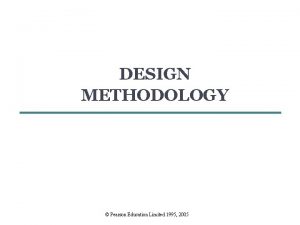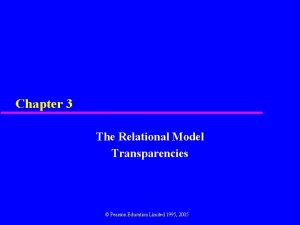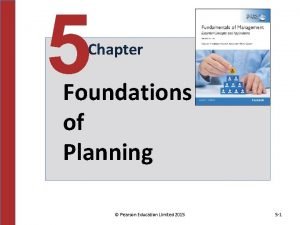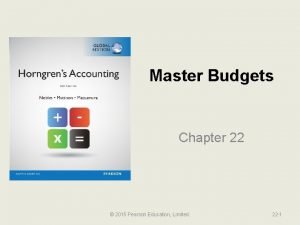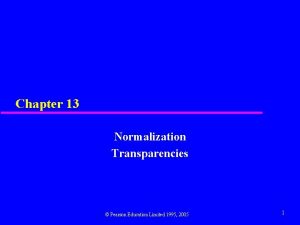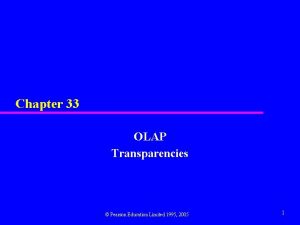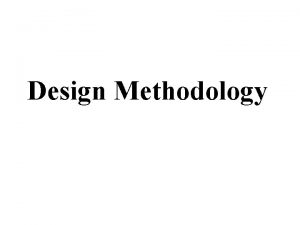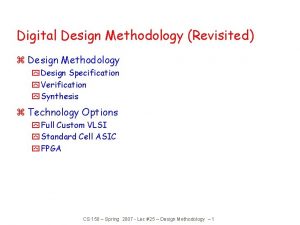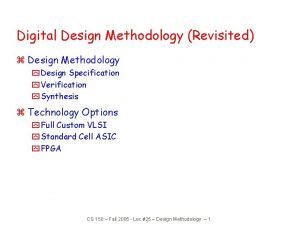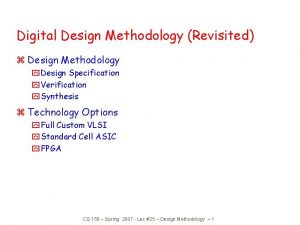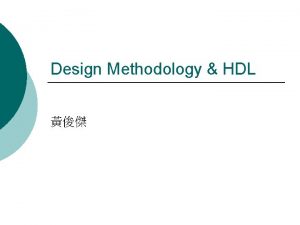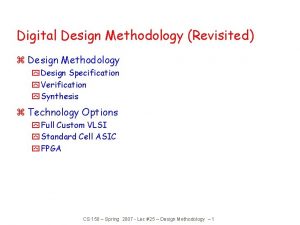DESIGN METHODOLOGY Pearson Education Limited 1995 2005 2



















- Slides: 19

DESIGN METHODOLOGY © Pearson Education Limited 1995, 2005

2 Objectives • The purpose of a design methodology. • Database design has three main phases: conceptual, logical, and physical design. • How to decompose the scope of the design into specific views of the enterprise. • How to use Entity–Relationship (ER) modeling to build a conceptual data model based on the data requirements of an enterprise. © Pearson Education Limited 1995, 2005

3 • How to validate the resultant conceptual model to ensure it is a true and accurate representation of the data requirements enterprise. • How to document the process of conceptual database design. • End-users play an integral role throughout the process of conceptual database design. © Pearson Education Limited 1995, 2005

4 Design Methodology • A structured approach that uses procedures, techniques, tools, and documentation aids to support and facilitate the process of design. • Three main phases: ▫ Conceptual database design ▫ Logical database design ▫ Physical database design © Pearson Education Limited 1995, 2005

5 Conceptual Database Design • The process of constructing a model of the data used in an enterprise, independent of all physical considerations. Logical Database Design • The process of constructing a model of the data used in an enterprise based on a specific data model (e. g. relational), but independent of a particular DBMS and other physical considerations. © Pearson Education Limited 1995, 2005

6 Physical Database Design • The process of producing a description of the implementation of the database on secondary storage; it describes the base relations, file organizations, and indexes design used to achieve efficient access to the data, and any associated integrity constraints and security measures. © Pearson Education Limited 1995, 2005

7 Critical Success Factors in Database Design • Work interactively with the users as much as possible. • Follow a structured methodology throughout the data modeling process. • Employ a data-driven approach. • Incorporate structural and integrity considerations into the data models. • Combine conceptualization, normalization, and transaction validation techniques into the data modeling methodology. © Pearson Education Limited 1995, 2005

8 Critical Success Factors in Database Design • Use diagrams to represent as much of the data models as possible. • Use a Database Design Language (DBDL) to represent additional data semantics. • Build a data dictionary to supplement the data model diagrams. • Be willing to repeat steps. © Pearson Education Limited 1995, 2005

9 Overview Database Design Methodology Conceptual database design • Step 1 Build conceptual data model ▫ Step 1. 1 Identify entity types ▫ Step 1. 2 Identify relationship types ▫ Step 1. 3 Identify and associate attributes with entity or relationship types ▫ Step 1. 4 Determine attribute domains ▫ Step 1. 5 Determine candidate, primary, and alternate key attributes © Pearson Education Limited 1995, 2005

10 Overview Database Design Methodology • Step 1 Build conceptual data model (continue) ▫ Step 1. 6 Consider use of enhanced modeling concepts (optional step) ▫ Step 1. 7 Check model for redundancy ▫ Step 1. 8 Validate conceptual model against user transactions ▫ Step 1. 9 Review conceptual data model with user © Pearson Education Limited 1995, 2005

11 Overview Database Design Methodology Logical database design for the relational model • Step 2 Build and validate logical data model ▫ Step 2. 1 Derive relations for logical data model ▫ Step 2. 2 Validate relations using normalization ▫ Step 2. 3 Validate relations against user transactions ▫ Step 2. 4 Define integrity constraints © Pearson Education Limited 1995, 2005

12 Overview Database Design Methodology • Step 2 Build and validate logical data model (continue) ▫ Step 2. 5 Review logical data model with user ▫ Step 2. 6 Merge logical data models into global model (optional step) ▫ Step 2. 7 Check for future growth © Pearson Education Limited 1995, 2005

13 Overview Database Design Methodology Physical database design for relational database • Step 3 Translate logical data model for target DBMS ▫ Step 3. 1 Design base relations ▫ Step 3. 2 Design representation of derived data ▫ Step 3. 3 Design general constraints © Pearson Education Limited 1995, 2005

14 Overview Database Design Methodology • Step 4 Design file organizations and indexes ▫ ▫ Step 4. 1 Step 4. 2 Step 4. 3 Step 4. 4 Analyze transactions Choose file organization Choose indexes Estimate disk space requirements © Pearson Education Limited 1995, 2005

15 Overview Database Design Methodology • Step 5 Design user views • Step 6 Design security mechanisms • Step 7 Consider the introduction of controlled redundancy • Step 8 Monitor and tune the operational system © Pearson Education Limited 1995, 2005

16 Step 1 Build Conceptual Data • To build a conceptual data model of the data requirements of the enterprise. ▫ Model comprises entity types, relationship types, attributes and attribute domains, primary and alternate keys, and integrity constraints. • Step 1. 1 Identify entity types ▫ To identify the required entity types. • Step 1. 2 Identify relationship types ▫ To identify the important relationships that exist between the entity types. © Pearson Education Limited 1995, 2005

17 Step 1 Build Conceptual Data • Step 1. 3 Identify and associate attributes with entity or relationship types ▫ To associate attributes with the appropriate entity or relationship types and document the details of each attribute. • Step 1. 4 Determine attribute domains ▫ To determine domains for the attributes in the data model and document the details of each domain. © Pearson Education Limited 1995, 2005

18 Step 1 Build Conceptual Data • Step 1. 5 Determine candidate, primary, and alternate key attributes ▫ To identify the candidate key(s) for each entity and if there is more than one candidate key, to choose one to be the primary key and the others as alternate keys. • Step 1. 6 Consider use of enhanced modeling concepts (optional step) ▫ To consider the use of enhanced modeling concepts, such as specialization / generalization, aggregation, and composition. © Pearson Education Limited 1995, 2005

19 Step 1 Build Conceptual Data Model • Step 1. 7 Check model for redundancy ▫ To check for the presence of any redundancy in the model and to remove any that does exist. • Step 1. 8 Validate conceptual model against user transactions ▫ To ensure that the conceptual model supports the required transactions. • Step 1. 9 Review conceptual data model with user ▫ To review the conceptual data model with the user to ensure that the model is a ‘true’ representation of the data requirements of the enterprise. © Pearson Education Limited 1995, 2005
 Pearson education limited 2005
Pearson education limited 2005 Pearson education limited 2005
Pearson education limited 2005 Pearson education limited 2008
Pearson education limited 2008 Pearson education ltd 2017
Pearson education ltd 2017 Copyright pearson education inc
Copyright pearson education inc Pearson education limited 2015
Pearson education limited 2015 Foundations of planning
Foundations of planning Pearson education limited 2015
Pearson education limited 2015 Pearson education limited 2015
Pearson education limited 2015 Pearson education limited 2015
Pearson education limited 2015 Pearson education limited 2015
Pearson education limited 2015 Pearson education limited 2015
Pearson education limited 2015 Pearson education limited 2008
Pearson education limited 2008 Pearson education limited 2015
Pearson education limited 2015 Pearson education limited 2015
Pearson education limited 2015 Pearson education limited 2008
Pearson education limited 2008 Master budget template
Master budget template 2011 pearson education
2011 pearson education Pearson education inc publishing as pearson prentice hall
Pearson education inc publishing as pearson prentice hall Pearson education inc publishing as pearson prentice hall
Pearson education inc publishing as pearson prentice hall
